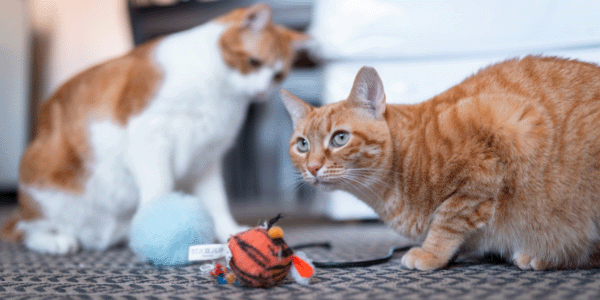 We tend to think cats are made for lazing around and sleeping all day. But actually, they’re designed to hunt and explore all day.
We tend to think cats are made for lazing around and sleeping all day. But actually, they’re designed to hunt and explore all day.
Are you giving your cat plenty of ways to stay active and engaged from dawn to dusk?
Toys are a big piece of that puzzle. We’re breaking down different types of toys, what they’re best for, and even how they can help you manage unwanted behaviors. Read on for the furry download on cat toys!
Skip Ahead
Toys that Replicate Hunting for Cats
Toys for Cats Who Chew
Toys for Cats to Self-Play
Electronic Cat Toys
Kicker Toys
The Best Toys for Cats with Limited Mobility
The Best Types of Toys for Kittens
Are Laser Toys OK for Cats?
How to Keep Your Cat from Getting Bored with Their Toys
Toys that Replicate Hunting for Cats
Cats are predators with an innate need to hunt. It’s not just about food. It’s instinct. So, it’s vital to give them acceptable ways to meet this need indoors. Keeping a stockpile of live mice around isn’t ideal, for obvious reasons. A wand toy, on the other hand, is perfect.
15 minutes of interactive play with you and a wand toy each day can be a game-changer for your cat!
How to Use Toys to Play with Your Cat
Take your cat through their natural prey sequence.
- First cats stare at their prey.
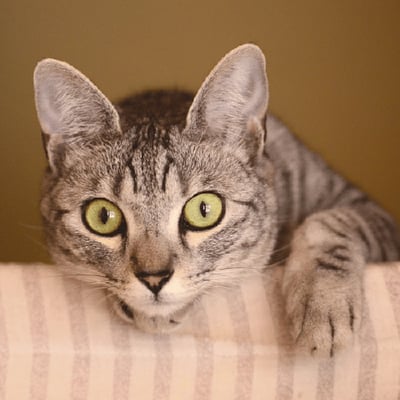
- Then they stalk and chase their prey.
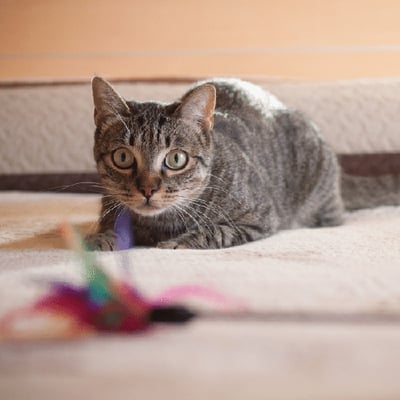
- At the perfect moment, they pounce or grab that prey.
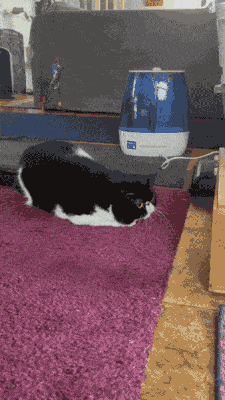
- And finally, they perform a kill-bite by taking it in their mouth and giving it a good shake (meant to break its neck) or wrapping their front legs around it and bunny kicking with the back legs (which we think is adorable even though it’s actually a disemboweling technique. Ick!).
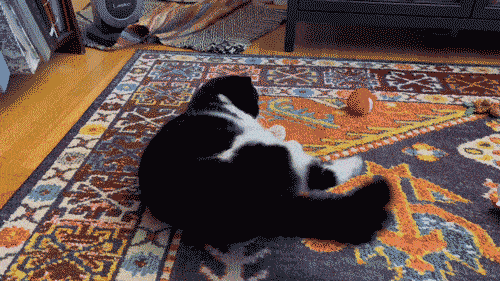
Use the wand toy to take them through these different steps. And remember, they’ll go back and forth, staring for a while, then attacking, then staring again, and so on.
If they stop chasing the toy and just sit there watching it, that doesn’t mean they’re done. They’ve just reset to the staring phase. So, keep playing!
Top Recommendations for Toys to Take Cats Through Prey Sequence
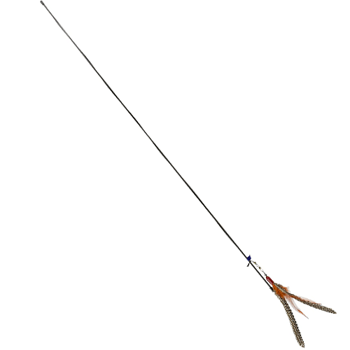
Look for an option that has a long, thin string so you can get a lot of movement from it. It’s also helpful to have a clasp on the end. This lets you try different lures to see what your cat likes and you can keep things fresh by switching lures in and out every few days. Da Bird is my absolute favorite.
Da Bird Wand Toy
Bumble Bee Lure (for use with Da Bird wand but can also be played with on its own)
Warning: Never allow cats to play with ‘string-type’ items unsupervised. This includes balls of yarn, rubber bands, etc.
The end of a string can become stuck somewhere along the gastrointestinal (GI) tract (tongue, teeth, in the stomach, or in the intestines). The other end of the string progresses down the GI tract. As the intestines attempt to move the free end further down the tract, they become bunched up (like an accordion). This can result in intestinal death as well as intestinal perforation and peritonitis, which is life-threatening. Surgery is often required.
Put Da Bird and other string toys away when you’re not actively playing with and supervising your cat.
Here is a video of Preventive Vet cat, Mazel, playing with Da Bird in his cat tree. Also, enjoy his fuzzy belly towards the end of the video.
Toys for Cats Who Chew
If your cat is a big chewer, it’s important to take a look at their lifestyle. Could this be a self-soothing behavior due to stress? Are they bored? Are they getting hungry between meals? Most importantly, are they actually ingesting what they’re chewing?
If your cat seems obsessed with chewing or is swallowing what they chew, it’s a good idea to talk with your veterinarian and a feline behavior consultant. Sometimes a few changes to their environment and giving them ways to decrease stress can reduce chewing. Giving them acceptable options for chewing can also be helpful.
Top toy picks for cats who like to chew
Chewy, meaty treats like Sheba Meaty Tender Sticks and Natural True Chews can give your cat a similar sensation as chewing things they shouldn’t.
There are cat toys specifically made for cats to chew. Whether your cat will actually use them that way or not depends on the cat.
Warning: Monitor cats closely when playing with these or any toys. If whole pieces are swallowed, they can be a choking hazard.
Pet Stages Catnip Oil Infused Dental Toy
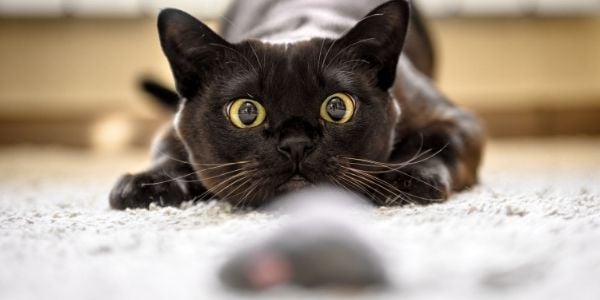
Things made for chewing that may not be safe for cats
Be cautious. Just because a product says cats can chew it doesn’t mean they should. This is especially true if your cat ingests what they chew.
Silvervine sticks are marketed as a chew option for cats. If you’re not familiar with it, silvervine has an effect similar to catnip but it’s usually more intense. It’s often sold in powder form. These sticks, however, are just that … sticks, usually with the bark on.
A cat who really chews could easily pull off pieces of the bark and stick. And these large splinters could get stuck in the soft pallet, wedged between the teeth, or worse yet, swallowed where they could pierce the stomach or intestines. I tried these once for my chewer and immediately realized it was way too risky.
If your cat enjoys silvervine, stick to the powder form and sprinkle it on a safer chew toy instead.
Dog chew toys are made for chewing. Can you use them for your cat? There’s no blanket answer. You have to look at the toy itself.
- It should be small enough that it will fit in your cat’s mouth without getting wedged in the jaw. Most dogs, even toy breeds, have larger mouths than the average cat.
- It should not be made of hard plastic. Cat teeth aren’t as durable as a dog’s. Furthermore, cats can have undiagnosed tooth resorption, which makes them fragile and they can break at the gum line.
- Make sure it doesn’t have any cords, fringe, or other soft pieces a cat could chew through.
Cat Toy Safety Tips
- Chew toys should only be given to your cat while supervised.
- Check toys regularly for signs of wear and tear. Get rid of toys as soon as they start to unravel or pieces come loose that your cat could swallow. This includes plastic eyes or ears, tails on furry mice, etc.
- Never give your cat bones to chew.
- Cotton swabs aren't technically made for cats to chew, but it happens quite often, and that can be dangerous.
Toys for Cats to Self-Play
Interactive play with you is important. But your cat should also be able to entertain themselves with play. The right toys can inspire that playful side.
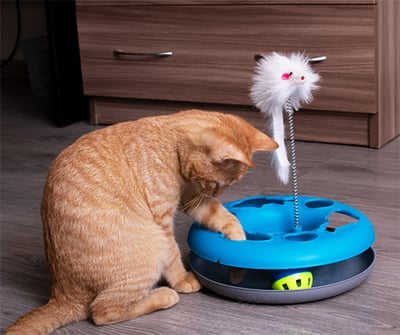 There are two important self-play toy categories: small toys they can bat around and toss in the air, and larger, stationary toys with elements that move.
There are two important self-play toy categories: small toys they can bat around and toss in the air, and larger, stationary toys with elements that move.
Furry mice, springs, and balls can have your cat flying around the house chasing them down. They’re also great for hiding while your cat seeks or dropping inside boxes with holes cut out for a little practice getting ground “prey” out of their burrows.
Larger toys, like balls that move around on a track, give your cat a different kind of play experience that’s just as much fun.
Remember the prey sequence though.
Since they can’t grab or kill bite anything with these track toys, it’s important to make sure they have other opportunities to go through those last two steps in the prey sequence. Otherwise, they may get frustrated after a big play session.
Our top picks for cat self-play toys
Electronic Cat Toys
Battery-powered toys can be a great option to entertain your cat, particularly during those times when they clearly need something to do but you’re not able to stop for a play session. This is a common problem with more people working from home. Turning on an electronic toy can help tide them over until you’re free for an interactive play session.
Our top electronic cat toy picks
Preventive Vet team member, Mia, puts the Pet Fusion Ambush toy away for most of the year and brings it out with the Christmas tree. When her cat Mazel gets too interested in the tree, she turns on the toy and it keeps his attention. In fact, if she can't find him in the house, she'll turn on the toy and suddenly he appears.
A word of warning: only use battery-powered toys that have a secure battery compartment. Many have tiny screws to ensure the battery won’t come loose during a crazy play session. The last thing you want is your cat playing with a dangerous battery.
Kicker Toys
Most cats love a good kicker. This is basically a stuffed toy that your cat can wrap around and bunny kick with their back feet like they would killing prey. Try different sizes and shapes to see what your cat likes. Some are furry, others crinkly. Some even come stuffed with catnip.
Behavior tip: If your cat gets overly aggressive during play or stalks your legs when you walk, kickers can help! Remember, the bunny kick is a natural behavior they need to engage in. The kicker gives them an appropriate outlet.
Keep one handy to give your cat BEFORE they go after your leg or arm. If they always ambush you in the same spot, like walking down the hallway, you can pre-emptively toss the kicker toy for your cat before you get to that spot. This will direct their attention to something they SHOULD attack instead of you.
Our top cat kicker toy picks
The Best Toys for Cats with Limited Mobility
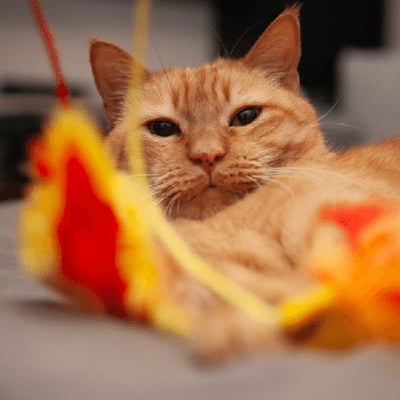
Arthritis and joint issues are very common in cats as they head into their senior years.
Along with any treatment and pain management your veterinarian recommends, it’s important to continue giving your cat ways to do “cat” things even if they can’t get around like they used to. Pay close attention to their movement and endurance levels though.
You never want to push past their limits! Even if it’s just batting at a toy from a seated position, hugging a catnip-filled kicker, or watching you fly a wand toy around the room, they’re still getting a chance to use their cat senses.
Cats with limited mobility may do better with larger toys they can grab more easily, battery-powered toys that move a bit slower, or track-and-ball toys they can get some motion out of without much physical exertion.
Wand toys are great because you can move them slowly and keep them in areas your cat can easily access, whether that’s right next to them on the couch or on the floor where they don’t have to jump around.
The Best Types of Toys for Kittens
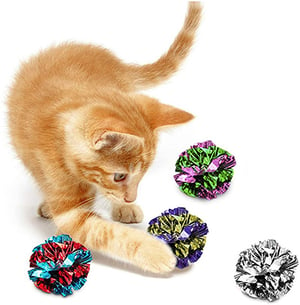 Kittens have an insane amount of energy. And as soon as they can walk, they start playing.
Kittens have an insane amount of energy. And as soon as they can walk, they start playing.
Not only is this important for socialization, but it also helps them hone their most instinctual skill — hunting. Toys are a big factor in helping your kitten burn off that energy, focus their hunting practice on acceptable options instead of your hands and feet, and learn how to entertain themselves.
Avoid toys with pieces that can easily be chewed off (or fall off). String is also a bad idea. You don’t want your kitten accidentally or intentionally swallowing anything they shouldn’t. If you have toys with long streamer-like elements the kitten can get tangled up in, put those away when you’re not supervising play.
Our top kitten toy recommendations
Are Laser Toys OK for Cats?
You may have heard about this debate. It’s thought by some that playing with a laser toy can actually be extremely stressful for cats. Go back to the prey sequence. The laser lets them stare, stalk, and chase. But they can’t pounce, grab, or kill bite their “prey.” You can imagine how frustrating that would be.
However, with a small addition to your laser play, you can make it a rewarding experience for your cat. Simply add in a toy that they can pounce, grab, and kill bite.
As you’re playing, have the laser occasionally land on a kicker toy or furry mouse so your cat can take out their predatory aggression on the toy. Then start moving the laser again. Or you can toss the mouse or kicker about every 20 seconds so your cat can chase it down for the pounce and kill bite.
Watch your cat throughout this process. If they seem panicky or obsessive about the laser, and incorporating a stuffed toy for attacking doesn’t help, they may not be well-suited for laser play. You want it to be fun, not stressful.
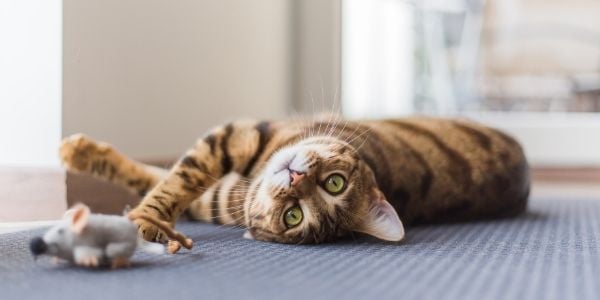
How to Keep Your Cat from Getting Bored with Their Toys
It’s no secret that cats quickly lose interest in their toys. But there are a few things you can do to keep things fresh and exciting.
- Put about half of your cat’s toys away. Once a week put away 20% of the toys you left out and replace them with toys you previously put away. Your cat always feels like they have something new to play with.
- Try rubbing toys with catnip or silvervine powder to make them more enticing.
- Put electronic toys away when your cat isn’t actively playing with them. Cats seem to lose interest in these quickly if they’re left out all the time.
- Find new and different ways to play with your cat. Wand toys don’t always have to fly in the air. They can slither on the ground, climb walls, or even hide and wiggle around to make noise. Furry mice are fun to throw. But you can also hide them along with a treat for hide-and-seek or drop them in a box with holes cut in it, so your cat can practice hunting ground critters. Be creative with play and switch things up often.
Toys are such an important part of cat life, whether they’re playing on their own or you’re having a play session together. Your cat is getting tons of enrichment and giving you just as much joy. Make playtime a priority. It’s worth it!




